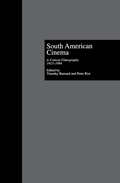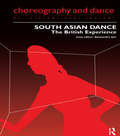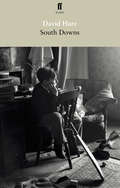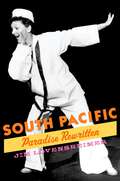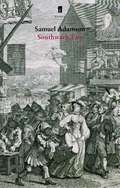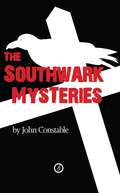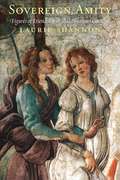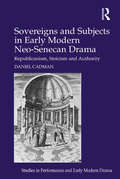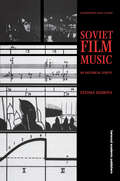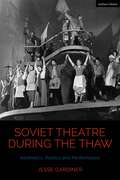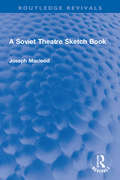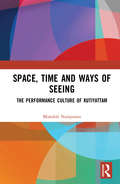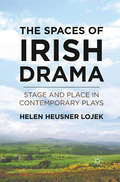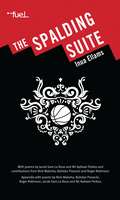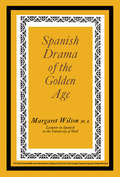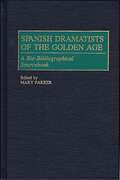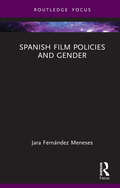- Table View
- List View
South American Cinema: A Critical Filmography, l915-l994
by Timothy Barnard Peter RistFirst Published in 1996. Routledge is an imprint of Taylor & Francis, an informa company.
South American Cinema: A Critical Filmography, l915-l994 (Historical Dictionaries Of Literature And The Arts Ser.)
by Timothy Barnard Peter RistFirst Published in 1996. Routledge is an imprint of Taylor & Francis, an informa company.
South Asian Dance: The British Experience
by Alessandra IyerFirst Published in 1998. Routledge is an imprint of Taylor & Francis, an informa company.
South Asian Dance: The British Experience
by Alessandra IyerFirst Published in 1998. Routledge is an imprint of Taylor & Francis, an informa company.
South Downs and Mere Fact, Mere Fiction
by David HareJohn Blakemore is a solitary boy who finds it impossible either to understand or adapt to the ways of the school. His adolescent earnestness put off teacher and pupil alike. And now suddenly he seems to be in danger of losing his only friend.David Hare's emotional new play, written at the invitation of the Rattigan estate as a response to The Browning Version, is a meditation on faith, learning and teenage friendship, played against the backdrop of a Britain still fighting to maintain an established rule.Collected with South Downs is the text of Hare's lecture Mere Fact, Mere Fiction, delivered to the Royal Society of Literature in 2010. In a famous defence of documentary theatre, the author celebrates the power of metaphor to transform factual quite as much as fictional material.
South Pacific: Paradise Rewritten (Broadway Legacies)
by Jim LovensheimerRodgers and Hammerstein's Tony and Pulitzer Prize-winning musical "South Pacific" has remained a mainstay of the American musical theater since it opened in 1949, and its powerful message about racial intolerance continues to resonate with twenty-first century audiences. Drawing on extensive research in the Rodgers and the Hammerstein papers, including Hammerstein's personal notes on James A. Michener's Tales of the South Pacific, Jim Lovensheimer offers a fascinating reading of "South Pacific" that explores the show's complex messages and demonstrates how the presentation of those messages changed throughout the creative process. Indeed, the author shows how Rodgers and especially Hammerstein continually refined and softened the theme of racial intolerance until it was more acceptable to mainstream Broadway audiences. Likewise, Lovensheimer describes the treatment of gender and colonialism in the musical, tracing how it both reflected and challenged early Cold War Era American norms. The book also offers valuable background to the writing of "South Pacific," exploring the earlier careers of both Rodgers and Hammerstein, showing how they frequently explored serious social issues in their other works, and discussing their involvement in the political movements of their day, such as Hammerstein's founding membership in the Hollywood Anti-Nazi League. Finally, the book features many wonderful appendices, including two that compare the original draft and final form of the classic songs "I'm Gonna Wash That Man Right Out-a My Hair" and "I'm In Love With a Wonderful Guy." Thoroughly researched and compellingly written, this superb book offers a rich, intriguing portrait of a Broadway masterpiece and the era in which it was created.
South Pacific: Paradise Rewritten (Broadway Legacies)
by Jim LovensheimerRodgers and Hammerstein's Tony and Pulitzer Prize-winning musical "South Pacific" has remained a mainstay of the American musical theater since it opened in 1949, and its powerful message about racial intolerance continues to resonate with twenty-first century audiences. Drawing on extensive research in the Rodgers and the Hammerstein papers, including Hammerstein's personal notes on James A. Michener's Tales of the South Pacific, Jim Lovensheimer offers a fascinating reading of "South Pacific" that explores the show's complex messages and demonstrates how the presentation of those messages changed throughout the creative process. Indeed, the author shows how Rodgers and especially Hammerstein continually refined and softened the theme of racial intolerance until it was more acceptable to mainstream Broadway audiences. Likewise, Lovensheimer describes the treatment of gender and colonialism in the musical, tracing how it both reflected and challenged early Cold War Era American norms. The book also offers valuable background to the writing of "South Pacific," exploring the earlier careers of both Rodgers and Hammerstein, showing how they frequently explored serious social issues in their other works, and discussing their involvement in the political movements of their day, such as Hammerstein's founding membership in the Hollywood Anti-Nazi League. Finally, the book features many wonderful appendices, including two that compare the original draft and final form of the classic songs "I'm Gonna Wash That Man Right Out-a My Hair" and "I'm In Love With a Wonderful Guy." Thoroughly researched and compellingly written, this superb book offers a rich, intriguing portrait of a Broadway masterpiece and the era in which it was created.
Southwark Fair
by Samuel AdamsonSimon is looking forward to lunch with Patrick Mulligan, the first man he slept with nearly twenty years previously, while playing Puck in a school production. It soon becomes apparent that Patrick is expecting to see not Simon, but the boy who played Lysander, and their lunch is cut short. When Simon is approached by Patrick's wife the situation becomes increasingly tortured and darkly comic.Southwark Fair premiered at the National Theatre, London, in February 2006.
The Southwark Mysteries
by John Constable“I was born a Goose of Southwark by the Grace of Mary Overie, Whose Bishop gives me licence to sin within The Liberty. In Bankside stews and taverns you can hear me honk right daintily, As I unlock the hidden door, unveil the Secret History.” The Liberty of the Clink dates back to 1107 when the Bishop of Winchester was granted a stretch of the Southwark Bankside, which lay outside the law of the City of London. Here, the Bishop controlled the brothels, or stews. The whores of The Liberty were known as Winchester Geese. The Vision Books of The Southwark Mysteries were first revealed by The Goose to John Crow, trickster-familiar of the poet and playwright John Constable, on 23rd November 1996. In these apocalyptic verses, John Crow encounters The Goose at Crossbones, the whores’ graveyard unearthed during work on the Jubilee Line Extension. She initiates him into a secret history spanning 2,000 years – a vision of the Spirit in the flesh, the Sacred in the profane, Eternity in time. This vision informs The Mystery Plays, a contemporary “Southwark Cycle” rooted in the medieval mysteries, retelling sacred stories in the earthy language and context of our own time and place. This epic drama was first performed in Shakespeare’s Globe and Southwark Cathedral on Easter Sunday, 23rd April 2000. A new production was presented in Southwark Cathedral in 2010. The third part of the work is a Glossolalia of local history and esoteric lore to be read in conjunction with the poems and plays." "Past and present, sacred and profane jostle and collide in a glorious tumult in this anarchic drama... it’s couched in verse that is muscular, ribald, and often dazzlingly rich... It’s sprawling and unashamedly ragged in execution, but it’s irrepressibly vital: a joyous, gutsy celebration of life, love, faith and forgiveness. " - Sam Marlowe, The Times
Sovereign Amity: Figures of Friendship in Shakespearean Contexts
by Laurie ShannonRenaissance formulations of friendship typically cast the friend as "another self" and idealized a pair of friends as "one soul in two bodies." Laurie Shannon's Sovereign Amity puts this stress on the likeness of friends into context and offers a historical account of its place in English culture and politics. Shannon demonstrates that the likeness of sex and station urged in friendship enabled a civic parity not present in other social forms. Early modern friendship was nothing less than a utopian political discourse. It preceded the advent of liberal thought, and it made its case in the terms of gender, eroticism, counsel, and kingship. To show the power of friendship in early modernity, Shannon ranges widely among translations of classical essays; the works of Elizabeth I, Montaigne, Donne, and Bacon; and popular literature, to focus finally on the plays of Shakespeare. Her study will interest scholars of literature, history, gender, sexuality, and political thought, and anyone interested in a general account of the English Renaissance.
Sovereigns and Subjects in Early Modern Neo-Senecan Drama: Republicanism, Stoicism and Authority
by Daniel CadmanSovereigns and Subjects in Early Modern Neo-Senecan Drama examines the development of neo-Senecan drama, also known as ’closet drama’, during the years 1590-1613. It is the first book-length study since 1924 to consider these plays - the dramatic works of Mary Sidney, Samuel Daniel, Samuel Brandon, Fulke Greville, Sir William Alexander, and Elizabeth Cary, along with the Roman tragedies of Ben Jonson and Thomas Kyd - as a coherent group. Daniel Cadman suggests these works interrogate the relations between sovereigns and subjects during the early modern period by engaging with the humanist discourses of republicanism and stoicism. Cadman argues that the texts under study probe various aspects of this dynamic and illuminate the ways in which stoicism and republicanism provide essential frameworks for negotiating this relationship between the marginalized courtier and the absolute sovereign. He demonstrates how aristocrats and courtiers, such as Sidney, Greville, Alexander, and Cary, were able to use the neo-Senecan form to consider aspects of their limited political agency under an absolute monarch, while others, such as Brandon and Daniel, respond to similarly marginalized positions within both political and patronage networks. In analyzing how these plays illuminate various aspects of early modern political culture, this book addresses several gaps in the scholarship of early modern drama and explores new contexts in relation to more familiar writers, as well as extending the critical debate to include hitherto neglected authors.
Sovereigns and Subjects in Early Modern Neo-Senecan Drama: Republicanism, Stoicism and Authority (Studies In Performance And Early Modern Drama Ser.)
by Daniel CadmanSovereigns and Subjects in Early Modern Neo-Senecan Drama examines the development of neo-Senecan drama, also known as ’closet drama’, during the years 1590-1613. It is the first book-length study since 1924 to consider these plays - the dramatic works of Mary Sidney, Samuel Daniel, Samuel Brandon, Fulke Greville, Sir William Alexander, and Elizabeth Cary, along with the Roman tragedies of Ben Jonson and Thomas Kyd - as a coherent group. Daniel Cadman suggests these works interrogate the relations between sovereigns and subjects during the early modern period by engaging with the humanist discourses of republicanism and stoicism. Cadman argues that the texts under study probe various aspects of this dynamic and illuminate the ways in which stoicism and republicanism provide essential frameworks for negotiating this relationship between the marginalized courtier and the absolute sovereign. He demonstrates how aristocrats and courtiers, such as Sidney, Greville, Alexander, and Cary, were able to use the neo-Senecan form to consider aspects of their limited political agency under an absolute monarch, while others, such as Brandon and Daniel, respond to similarly marginalized positions within both political and patronage networks. In analyzing how these plays illuminate various aspects of early modern political culture, this book addresses several gaps in the scholarship of early modern drama and explores new contexts in relation to more familiar writers, as well as extending the critical debate to include hitherto neglected authors.
Soviet Film Music (Contemporary Music Studies)
by Tatiana EgorovaFirst Published in 1998. Routledge is an imprint of Taylor & Francis, an informa company.
Soviet Film Music (Contemporary Music Studies)
by Tatiana EgorovaFirst Published in 1998. Routledge is an imprint of Taylor & Francis, an informa company.
Soviet Theatre during the Thaw: Aesthetics, Politics and Performance (Cultural Histories of Theatre and Performance)
by Jesse GardinerThe era known as the Thaw (1953-64) was a crucial period in the history of the Soviet Union. It was a time when the legacies of Stalinism began to unravel and when brief moments of liberalisation saw dramatic changes to society. By exploring theatre productions, plays and cultural debates during the Thaw, this book sheds light on a society in flux, in which the cultural norms, values and hierarchies of the previous era were being rethought. Jesse Gardiner demonstrates that the revival of avant-garde theatre during the Thaw was part of a broader re-engagement with cultural forms that had been banned under Stalin. Plays and productions that had fallen victim to the censor were revived or reinvented, and their authors and directors rehabilitated alongside waves of others who had been repressed during the Stalinist purges. At the same time, new theatre companies and practitioners emerged who reinterpreted the stylized techniques of the avant-garde for a post-war generation. This book argues that the revival of avant-garde theatre was vital in allowing the Soviet public to reimagine its relationship to state power, the West and its own past. It permitted the rethinking of attitudes and prejudices, and led to calls for greater cultural diversity across society. Playwrights, directors and actors began to work in innovative ways, seeking out the theatre of the future by re-engaging with the proscribed forms of the past.
Soviet Theatre during the Thaw: Aesthetics, Politics and Performance (Cultural Histories of Theatre and Performance)
by Jesse GardinerThe era known as the Thaw (1953-64) was a crucial period in the history of the Soviet Union. It was a time when the legacies of Stalinism began to unravel and when brief moments of liberalisation saw dramatic changes to society. By exploring theatre productions, plays and cultural debates during the Thaw, this book sheds light on a society in flux, in which the cultural norms, values and hierarchies of the previous era were being rethought. Jesse Gardiner demonstrates that the revival of avant-garde theatre during the Thaw was part of a broader re-engagement with cultural forms that had been banned under Stalin. Plays and productions that had fallen victim to the censor were revived or reinvented, and their authors and directors rehabilitated alongside waves of others who had been repressed during the Stalinist purges. At the same time, new theatre companies and practitioners emerged who reinterpreted the stylized techniques of the avant-garde for a post-war generation. This book argues that the revival of avant-garde theatre was vital in allowing the Soviet public to reimagine its relationship to state power, the West and its own past. It permitted the rethinking of attitudes and prejudices, and led to calls for greater cultural diversity across society. Playwrights, directors and actors began to work in innovative ways, seeking out the theatre of the future by re-engaging with the proscribed forms of the past.
A Soviet Theatre Sketch Book (Routledge Revivals)
by Joseph MacleodFirst Published in 1951, A Soviet Theatre Sketch Book presents Joseph Macleod’s take on Russian Theatre in a semi-fictional way to show the effect of the productions upon different audiences. By using his pen as an artist uses his pencil, he gives, for the first time, an account of theatre audiences as composed of individual human beings and is able to paint the scenes vividly without neglecting the technical methods of the Soviet stage. By supple use of the sketch- book form, theatres, theatre-schools, actors, and actresses including some no longer appearing are painted into an all-over view of Russian and Ukrainian post-war life. In this book the author writes less immediately about the Soviet Union and does not depend on topicality or stop press news. Joseph Macleod and his wife visited the Soviet Union as the guests of the Russian and Ukrainian Societies for Cultural Relations with Foreign Countries. This book will be of interest to scholars and researchers of theatre, history of theatre, and performance studies.
A Soviet Theatre Sketch Book (Routledge Revivals)
by Joseph MacleodFirst Published in 1951, A Soviet Theatre Sketch Book presents Joseph Macleod’s take on Russian Theatre in a semi-fictional way to show the effect of the productions upon different audiences. By using his pen as an artist uses his pencil, he gives, for the first time, an account of theatre audiences as composed of individual human beings and is able to paint the scenes vividly without neglecting the technical methods of the Soviet stage. By supple use of the sketch- book form, theatres, theatre-schools, actors, and actresses including some no longer appearing are painted into an all-over view of Russian and Ukrainian post-war life. In this book the author writes less immediately about the Soviet Union and does not depend on topicality or stop press news. Joseph Macleod and his wife visited the Soviet Union as the guests of the Russian and Ukrainian Societies for Cultural Relations with Foreign Countries. This book will be of interest to scholars and researchers of theatre, history of theatre, and performance studies.
Space, Time and Ways of Seeing: The Performance Culture of Kutiyattam
by Mundoli NarayananThis volume explores the constitutive role played by space in the performance of Kutiyattam. The only surviving form of Sanskrit theatre, Kutiyattam is distinctive in terms of its performance conventions and its unique culture of extensive elaboration and interpretation. Drawing upon the concepts of phenomenology on the processes of perception, particularly on the works of Edmund Husserl, Martin Heidegger and Maurice Merleau-Ponty, it analyses the role of space in the communicative structures of performance of Kutiyattam and its contribution to the production of meaning in theatre, especially in the context of contemporary theatre. The book explores the theatrical event as a phenomenon that comes into existence through a triangular relationship among the ‘ways of being’ of the performers, the ‘ways of seeing’ of the audience, and the space which brings them together. Based on this formulation, Kutiyattam is approached as a ‘theatre of elaboration,’ made possible by the ‘intimate,’ ‘proximal’ ways of seeing of the audience, in the particular theatrical space of the kūttampalaṃs, the temple theatres, where Kutiyattam has customarily been performed for more than five centuries. This volume will be of great interest to scholars and researchers of cultural studies, theatre and performance studies, cultural anthropology, phenomenology and South Asian studies.
Space, Time and Ways of Seeing: The Performance Culture of Kutiyattam
by Mundoli NarayananThis volume explores the constitutive role played by space in the performance of Kutiyattam. The only surviving form of Sanskrit theatre, Kutiyattam is distinctive in terms of its performance conventions and its unique culture of extensive elaboration and interpretation. Drawing upon the concepts of phenomenology on the processes of perception, particularly on the works of Edmund Husserl, Martin Heidegger and Maurice Merleau-Ponty, it analyses the role of space in the communicative structures of performance of Kutiyattam and its contribution to the production of meaning in theatre, especially in the context of contemporary theatre. The book explores the theatrical event as a phenomenon that comes into existence through a triangular relationship among the ‘ways of being’ of the performers, the ‘ways of seeing’ of the audience, and the space which brings them together. Based on this formulation, Kutiyattam is approached as a ‘theatre of elaboration,’ made possible by the ‘intimate,’ ‘proximal’ ways of seeing of the audience, in the particular theatrical space of the kūttampalaṃs, the temple theatres, where Kutiyattam has customarily been performed for more than five centuries. This volume will be of great interest to scholars and researchers of cultural studies, theatre and performance studies, cultural anthropology, phenomenology and South Asian studies.
The Spaces of Irish Drama: Stage and Place in Contemporary Plays
by H. LojekLojek provides extensive analysis of space in plays by living Irish playwrights, applying practical understandings of staging and the insights of geographers and spatial theorists to drama in an era increasingly aware of space.
The Spalding Suite (Oberon Modern Plays)
by Inua EllamsWhen we were young, we worshipped stars, gleaming long-limbed gods framed in the act of impossible flight. For a time we tried to follow, to carve out our own piece of sky with a butter-smooth arc of an arm and a Spalding ball glued to the fingertips…br Seen from a British perspective, The Spalding Suite gets to the heart and soul of the gravity-defying game and delves into the hopes and dreams of those who play it. From the fleeting high of the score and the robust camaraderie of the team, to the poignant lows of a body too worn to play the game.
Spanish Drama of the Golden Age: The Commonwealth and International Library: Pergamon Oxford Spanish Division
by Margaret WilsonSpanish Drama of the Golden Age describes this little-known field of European drama. This book describes and analyzes Spanish plays and drama. It reviews the Spanish plays from the 1580s to the death of Pedro Calderon de la Barca in 1681. This text also discusses the controversy to which direction the Spanish theater would take: whether it is for entertainment or a representation of the intellect and emotions. This book describes Miguel de Cervantes, Lope de Vega, and the rise of the Spanish comedia. The text describes how Lope wrote his plays and how he sold them outright to the manager of an acting company, which became its property. The text also describes the life of Tirso de Molina who was often criticized for his cavalier treatment of a historical fact. This book also discusses the works of Ruiz de Alarcon, Guillen de Castro, Velez de Guevara, and Mira de Amescua. This book also assess this period of Spanish drama in terms of the influence of other countries in Europe such as Britain and France. This book can prove valuable for university students of Spanish, Spanish literature teachers to students of sixth forms, and Spanish historians.
Spanish Dramatists of the Golden Age: A Bio-Bibliographical Sourcebook (Non-ser.)
by Mary ParkerThe Golden Age of Spanish drama extends from the close of the 15th century to the death of Calderón in 1681. During that time, the humanists, as dramatists, followed Italy's artistic awakening direction, and imitated Classical drama. With originality and dreams of greatness, they subverted the nature of tragedy; modified the approach of Comedy and invented the New Play, the Comedia Nueva. In it the poet-dramatists introduced important modificaitons of realism, included imagined reality, Christian symbolism and theatricality, as artistic truth. They elaborate all kinds of syntheses. For this reason, the Spanish Golden Age theater can be viewed as part of a tradition that includes the Greco-Roman comedy and tragedy, Christian tragedy, and the authentic national literary and dramatic tendencies.The entries in this reference book explore the fascinating history of the Golden Age of Spanish drama. The volume begins with an introductory overview of the literary, cultural, and historical contexts that shaped dramatic writing of the period. The book then presents alphabetically arranged essays for nineteen significant Spanish dramatists of the Golden Age. Each essay is written by an expert contributor and includes biographical information, an analysis and evaluation of major works, a discussion of critical response to the plays, and an extensive bibliography of primary and secondary sources. The volume closes with a selected general bibliography of central critical studies of Golden Age Spanish drama.
Spanish Film Policies and Gender (Routledge Focus on Media and Cultural Studies)
by Jara Fernández MenesesThis book provides a comprehensive cultural and historical account of the key film policies put into place by the Spanish state between 1980 and 2010 through a gendered lens, framing these policies within the wider context of European film legislation.Departing from the belief that there is no such thing as an objective and value-neutral approach to policy analysis because our society is organised around gender, this volume builds upon Pierre Bourdieu’s theory of field to propose that film policies do not emerge in a vacuum because they respond to different demands from those agents involved in the field of the Spanish cinema. By so doing, it critically assesses how these policies have come into being, by whom, in response to what interests, how they have shaped the Spanish film industry, and how far and in what ways they have tackled gender inequality in the Spanish film industry.This book will be of great interest to scholars and students of Spanish cinema, gender studies, film industry studies, film policy, and feminist film studies.
